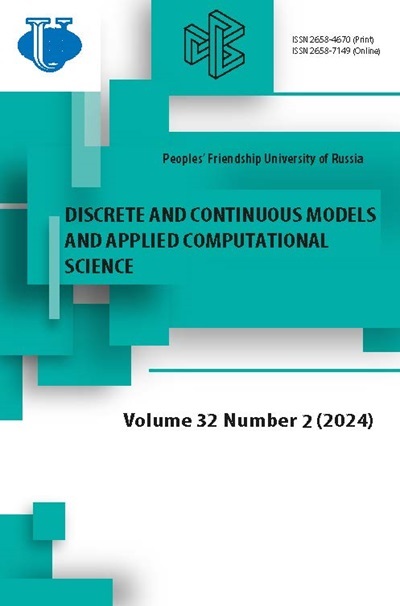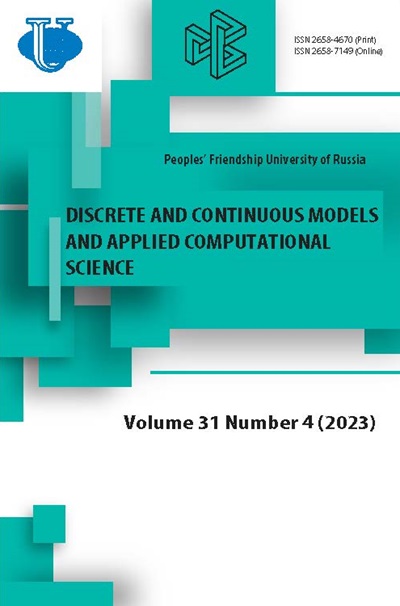Демографические показатели, модели и проверка
- Авторы: Шиловский Г.А.1,2, Селиверстов А.В.1, Зверков О.А.1
-
Учреждения:
- Институт проблем передачи информации имени А. А. Харкевича РАН
- Московский государственный университет имени М. В. Ломоносова
- Выпуск: Том 31, № 4 (2023)
- Страницы: 359-374
- Раздел: Статьи
- URL: https://journals.rudn.ru/miph/article/view/37516
- DOI: https://doi.org/10.22363/2658-4670-2023-31-4-359-374
- EDN: https://elibrary.ru/FZWSUR
Цитировать
Полный текст
Аннотация
Используя простые демографические показатели для описания динамики смертности, можно скрыть важные особенности кривой выживания, особенно в периоды быстрых изменений, вызванных, например, внутренними или внешними факторами, и особенно в самом старшем или самом молодом возрасте. Поэтому вместо общепринятого метода Гомпертца часто используются другие методы, основанные на демографических показателях. У человека хронический феноптоз, в отличие от возрастно-независимого острого феноптоза, проявляется ректангуляризацией кривой выживания с одновременным увеличением средней продолжительности жизни при рождении в результате развития общества и научно-технического прогресса. Несмотря на простую геометрическую интерпретацию явления ректангуляризации кривой выживания, его трудно заметить, прослеживая лишь изменения оптимальных коэффициентов в законе Гомпертца-Мейкхама из-за высокой вычислительной сложности, а также увеличения погрешности расчёта. Этого можно избежать путём расчёта демографических показателей, таких как энтропия Кейфитца, коэффициент Джини и коэффициент вариации продолжительности жизни. Как теоретические примеры, так и расчёты, основанные на реальных демографических данных, показывают, что при одинаковом значении коэффициента Джини в сравниваемых когортах большее значение энтропии Кейфитца указывает на большую долю долгожителей относительно средней продолжительности жизни. Напротив, при том же значении энтропии Кейфитца большее значение коэффициента Джини соответствует относительно большой смертности в молодом возрасте. Мы предполагаем, что уменьшение энтропии Кейфица может быть связано со снижением фоновой смертности, отражённой в модели Мейкхама, или со снижением смертности в более раннем возрасте, что соответствует изменениям в другом коэффициенте закона Гомпертца. Другой причиной может быть снижение смертности в малых возрастах, что соответствует уменьшению другого коэффициента в законе Гомпертца. Включив динамические возрастные изменения в анализ выживаемости, мы можем углубить наше понимание моделей смертности и механизмов старения, что в конечном итоге внесёт вклад в разработку более надёжных методов оценки эффективности мер против старения и геропротекторов, используемых в геронтологии.
Об авторах
Г. А. Шиловский
Институт проблем передачи информации имени А. А. Харкевича РАН; Московский государственный университет имени М. В. Ломоносова
Автор, ответственный за переписку.
Email: gregory_sh@list.ru
ORCID iD: 0000-0001-5017-8331
Candidate of Biological Sciences, Senior Researcher in Laboratory 6 at Institute for Information Transmission Problems of the Russian Academy of Sciences (Kharkevich Institute); Researcher in Faculty of Biology at Lomonosov Moscow State University
Большой каретный пер., д. 19, стр. 1, Москва, 127051, Российская Федерация; Ленинские горы, д. 1, стр. 12, Москва, 119991, Российская ФедерацияА. В. Селиверстов
Институт проблем передачи информации имени А. А. Харкевича РАН
Email: slvstv@iitp.ru
ORCID iD: 0000-0003-4746-6396
Candidate of Physical and Mathematical Sciences, Leading Researcher in Laboratory 6
Большой каретный пер., д. 19, стр. 1, Москва, 127051, Российская ФедерацияО. А. Зверков
Институт проблем передачи информации имени А. А. Харкевича РАН
Email: zverkov@iitp.ru
ORCID iD: 0000-0002-8546-364X
Candidate of Physical and Mathematical Sciences, Researcher in Laboratory 6
Большой каретный пер., д. 19, стр. 1, Москва, 127051, Российская ФедерацияСписок литературы
- D. Avraam, J. P. de Magalhaes, and B. Vasiev, “A mathematical model of mortality dynamics across the lifespan combining heterogeneity and stochastic effects,” Experimental Gerontology, vol. 48, no. 8, pp. 801-811, 2013. doi: 10.1016/j.exger.2013.05.054.
- F. Colchero and B. Y. Kiyakoglu, “Beyond the proportional frailty model: Bayesian estimation of individual heterogeneity on mortality parameters,” Biometrical Journal, vol. 62, no. 1, pp. 124-135, 2020. doi: 10.1002/bimj.201800280.
- N. Hartemink, T. I. Missov, and H. Caswell, “Stochasticity, heterogeneity, and variance in longevity in human populations,” Theoretical Population Biology, vol. 114, pp. 107-116, 2017. doi: 10.1016/j.tpb.2017.01.001.
- O. R. Jones, A. Scheuerlein, R. Salguero-Gómez, et al., “Diversity of ageing across the tree of life,” Nature, vol. 505, no. 7482, pp. 169-173, 2014. doi: 10.1038/nature12789.
- A. Moskalev, Z. Guvatova, et al., “Targeting aging mechanisms: pharmacological perspectives,” Trends in Endocrinology & Metabolism, vol. 33, no. 4, pp. 266-280, 2022. doi: 10.1016/j.tem.2022.01.007.
- L. I. Rubanov, A. G. Zaraisky, G. A. Shilovsky, A. V. Seliverstov, O. A. Zverkov, and V. A. Lyubetsky, “Screening for mouse genes lost in mammals with long lifespans,” BioData Mining, vol. 12, p. 20, 2019. doi: 10.1186/s13040-019-0208-x.
- M. I. Mosevitsky, “Progerin and its role in accelerated and natural aging,” Molecular Biology, vol. 56, no. 2, pp. 125-146, 2022. doi: 10.1134/S0026893322020091.
- G. A. Shilovsky, “Variability of mortality: Additional information on mortality and morbidity curves under normal and pathological conditions,” Biochemistry (Moscow), vol. 87, no. 3, pp. 294-299, 2022. doi: 10.1134/S0006297922030087.
- D. A. Jdanov, A. A. Galarza, V. M. Shkolnikov, et al., “The shortterm mortality fluctuation data series, monitoring mortality shocks across time and space,” Scientific Data, vol. 8, no. 1, p. 235, 2021. doi: 10.1038/s41597-021-01019-1.
- V. P. Skulachev, G. A. Shilovsky, et al., “Perspectives of Homo sapiens lifespan extension: focus on external or internal resources?” Aging, vol. 12, no. 6, pp. 5566-5584, 2020. doi: 10.18632/aging.102981.
- R. Edwards, “Who is hurt by procyclical mortality?” Social Science & Medicine, vol. 67, no. 12, pp. 2051-2058, 2008. doi: 10.1016/j.socscimed.2008.09.032.
- I. I. Vasilyeva, A. V. Demidova, O. V. Druzhinina, and O. N. Masina, “Construction, stochastization and computer study of dynamic population models “two competitors - two migration areas”,” Discrete and Continuous Models and Applied Computational Science, vol. 31, no. 1, pp. 27-45, 2023. doi: 10.22363/2658-4670-2023-31-1-27-45.
- D. Hainaut and M. Denuit, “Wavelet-based feature extraction for mortality projection,” ASTIN Bulletin, vol. 50, no. 3, pp. 675-707, 2020. doi: 10.1017/asb.2020.18.
- S. Ebmeier, D. Thayabaran, I. Braithwaite, C. Bénamara, M. Weatherall, and R. Beasley, “Trends in international asthma mortality: analysis of data from the WHO Mortality Database from 46 countries (1993-2012),” The Lancet, vol. 390, no. 10098, pp. 935-945, 2017. doi: 10.1016/S0140-6736(17)31448-4.
- H. J. A. Rolden, J. H. T. Rohling, et al., “Seasonal variation in mortality, medical care expenditure and institutionalization in older people: Evidence from a Dutch cohort of older health insurance clients,” PLOS ONE, vol. 10, no. 11, e0143154, 2015. doi: 10.1371/journal.pone. 0143154.
- A. Ledberg, “A large decrease in the magnitude of seasonal fluctuations in mortality among elderly explains part of the increase in longevity in Sweden during 20th century,” BMC Public Health, vol. 20, p. 1674, 2020. doi: 10.1186/s12889-020-09749-4.
- J. P. Kooman, L. A. Usvyat, M. J. E. Dekker, et al., “Cycles, arrows and turbulence: Time patterns in renal disease, a path from epidemiology to personalized medicine?” Blood Purification, vol. 47, no. 1-3, pp. 171- 184, 2019. doi: 10.1159/000494827.
- J. A. Barthold Jones, A. Lenart, and A. Baudisch, “Complexity of the relationship between life expectancy and overlap of lifespans,” PLoS One, vol. 13, no. 7, e0197985, 2018. doi: 10.1371/journal.pone.0197985.
- J. M. Aburto, U. Basellini, A. Baudisch, and F. Villavicencio, “Drewnowski’s index to measure lifespan variation: Revisiting the Gini coefficient of the life table,” Theoretical Population Biology, vol. 148, pp. 1-10, 2022. doi: 10.1016/j.tpb.2022.08.003.
- B. Gompertz, “XXIV. On the nature of the function expressive of the law of human mortality, and on a new mode of determining the value of life contingencies,” Philosophical Transactions of the Royal Society of London, vol. 115, pp. 513-583, 1825. doi: 10.1098/rstl.1825.0026.
- E. S. Deevey, “Life tables for natural populations of animals,” The Quarterly Review of Biology, vol. 22, no. 4, pp. 283-314, 1947. doi: 10.1086/395888.
- A. V. Khalyavkin, “Influence of environment on the mortality pattern of potentially non-senescent organisms. General approach and comparison with real populations,” Advances in Gerontology, vol. 7, pp. 46-49, 2001.
- S. V. Myl’nikov, “Towards the estimation of survival curves parameters and geroprotectors classification,” Advances in gerontology, vol. 24, no. 4, pp. 563-569, 2011.
- R. E. Ricklefs, “Life-history connections to rates of aging in terrestrial vertebrates,” Proceedings of the National Academy of Sciences, vol. 107, no. 22, pp. 10 314-10 319, 2010. doi: 10.1073/pnas.1005862107.
- J. W. Vaupel, J. R. Carey, K. Christensen, et al., “Biodemographic trajectories of longevity,” Science, vol. 280, no. 5365, pp. 855-860, 1998. doi: 10.1126/science.280.5365.855.
- A. V. Markov, “Can kin selection facilitate the evolution of the genetic program of senescence?” Biochemistry (Moscow), vol. 77, no. 7, pp. 733-741, 2012. doi: 10.1134/S0006297912070061.
- M. Skulachev, F. Severin, and V. Skulachev, “Aging as an evolvabilityincreasing program which can be switched off by organism to mobilize additional resources for survival,” Current Aging Science, vol. 8, no. 1, pp. 95-109, 2015. doi: 10.2174/1874609808666150422122401.
- N. S. Gavrilova and L. A. Gavrilov, “Are we approaching a biological limit to human longevity?” The Journals of Gerontology: Series A, vol. 75, no. 6, pp. 1061-1067, 2020. doi: 10.1093/gerona/glz164.
- W. M. Makeham, “On the law of mortality and the construction of annuity tables,” The Assurance Magazine, and Journal of the Institute of Actuaries, vol. 8, no. 6, pp. 301-310, 1860.
- G. A. Shilovsky, T. S. Putyatina, A. V. Markov, and V. P. Skulachev, “Contribution of quantitative methods of estimating mortality dynamics to explaining mechanisms of aging,” Biochemistry (Moscow), vol. 80, no. 12, pp. 1547-1559, 2015. doi: 10.1134/S0006297915120020.
- N. Keyfitz, “What difference would it make if cancer were eradicated? An examination of the Taeuber paradox,” Demography, vol. 14, no. 4, pp. 411-418, 1977. doi: 10.2307/2060587.
- Z. Zhang and J. Vaupel, “The age separating early deaths from late deaths,” Demographic Research, vol. 20, pp. 721-730, 2009. doi: 10.4054/DemRes.2009.20.29.
- J. Oeppen and J. W. Vaupel, “Broken limits to life expectancy,” Science, vol. 296, no. 5570, pp. 1029-1031, 2002. doi: 10.1126/science.1069675.
- F. Colchero, R. Rau, O. R. Jones, et al., “The emergence of longevous populations,” Proceedings of the National Academy of Sciences, vol. 113, no. 48, pp. 7681-7690, 2016. doi: 10.1073/pnas.1612191113.
- L. Németh, “Life expectancy versus lifespan inequality: A smudge or a clear relationship?” PLOS ONE, vol. 12, no. 9, e0185702, 2017. doi: 10.1371/journal.pone.0185702.
- E. R. Galimov, J. N. Lohr, and D. Gems, “When and how can death be an adaptation?” Biochemistry (Moscow), vol. 84, no. 12-13, pp. 1433-1437, 2019. doi: 10.1134/S0006297919120010.
- G. A. Shilovsky, T. S. Putyatina, S. N. Lysenkov, V. V. Ashapkin, O. S. Luchkina, A. V. Markov, and V. P. Skulachev, “Is it possible to prove the existence of an aging program by quantitative analysis of mortality dynamics?” Biochemistry (Moscow), vol. 81, no. 12, pp. 1461-1476, 2016. doi: 10.1134/S0006297916120075.
- G. A. Shilovsky, T. S. Putyatina, V. V. Ashapkin, O. S. Luchkina, and A. V. Markov, “Coefficient of variation of lifespan across the tree of life: Is it a signature of programmed aging?” Biochemistry (Moscow), vol. 82, no. 12, pp. 1480-1492, 2017. doi: 10.1134/S0006297917120070.
- T. F. Wrycza, T. I. Missov, and A. Baudisch, “Quantifying the shape of aging,” PLOS ONE, vol. 10, no. 3, e0119163, 2015. doi: 10.1371/journal.pone.0119163.
- M. Boldrini, “Corrado Gini,” Journal of the Royal Statistical Society. Series A (General), vol. 129, no. 1, pp. 148-150, 1966.
- K. Hanada, “A formula of Gini’s concentration ratio and its application to life tables,” Journal of the Japan Statistical Society, Japanese Issue, vol. 13, no. 2, pp. 95-98, 1983. doi: 10.11329/jjss1970.13.95.
- V. Shkolnikov, E. Andreev, and A. Z. Begun, “Gini coefficient as a life table function,” Demographic Research, vol. 8, pp. 305-358, 2003. doi: 10.4054/DemRes.2003.8.11.
- J. Smits and C. Monden, “Length of life inequality around the globe,” Social Science & Medicine, vol. 68, no. 6, pp. 1114-1123, 2009. doi: 10.1016/j.socscimed.2008.12.034.
- N. S. Gavrilova, L. A. Gavrilov, F. F. Severin, and V. P. Skulachev, “Testing predictions of the programmed and stochastic theories of aging: Comparison of variation in age at death, menopause, and sexual maturation,” Biochemistry (Moscow), vol. 77, no. 7, pp. 754-760, 2012. doi: 10.1134/S0006297912070085.
- A. Comfort, The biology of senescence. Elsevier, 1979.
















